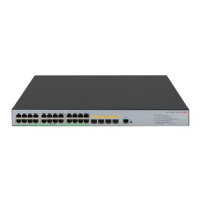416
IMPORTANT:
If IPv6 PIM snooping–enabled switches are deployed in the IPv6 PIM network, be sure to set a value no
greater than the IPv6 path MTU for the maximum size of each join/prune message on the receiver-side
edge IPv6 PIM devices.
To configure join/prune message sizes:
Ste
Command Remarks
1. Enter system view.
system-view N/A
2. Enter IPv6 PIM view.
pim ipv6 N/A
3. Configure the maximum size
of each join/prune message.
jp-pkt-size packet-size
Optional.
8100 bytes by default.
4. Configure the maximum
number of (S, G) entries in a
join/prune message.
jp-queue-size queue-size
Optional.
1020 by default.
Configuring IPv6 PIM to work with BFD
IPv6 PIM uses hello messages to elect a DR for a multi-access network. The elected DR will be the only
multicast forwarder on the multi-access network.
If the DR fails, a new DR election process will start after the DR is aged out. However, it might take a long
period of time. To start a new DR election process immediately after the original DR fails, you can enable
IPv6 PIM to work with Bidirectional Forwarding Detection (BFD) on a multi-access network to detect
failures of the links among IPv6 PIM neighbors. You must enable IPv6 PIM to work with BFD on all IPv6
PIM-capable routers on a multi-access network, so that the IPv6 PIM neighbors can fast detect DR failures
and start a new DR election process.
Before you configure this feature on an interface, be sure to enable IPv6 PIM-DM or IPv6 PIM-SM on the
interface.
To enable IPv6 PIM to work with BFD:
Ste
Command
Remarks
1. Enter system view.
system-view N/A
2. Enter interface view.
interface interface-type interface-number N/A
3. Enable IPv6 PIM to
work with BFD.
pim ipv6 bfd enable Disabled by default
For more information about BFD, see High Availability Configuration Guide.

